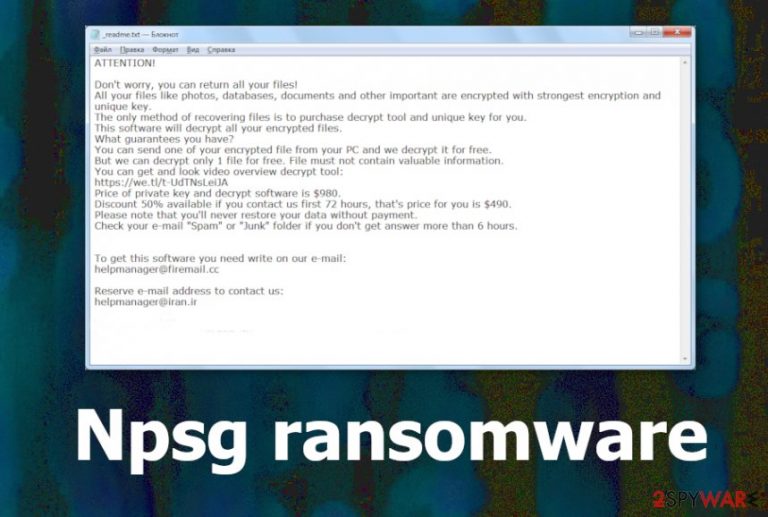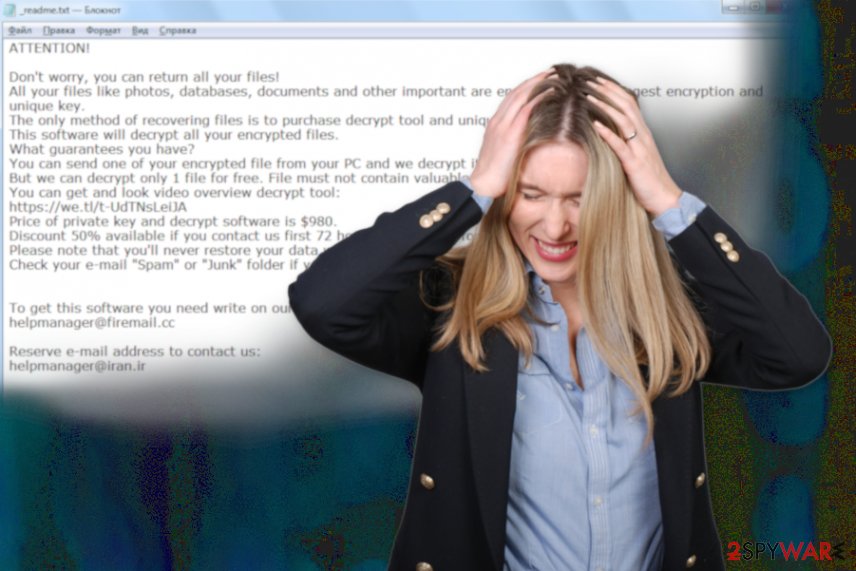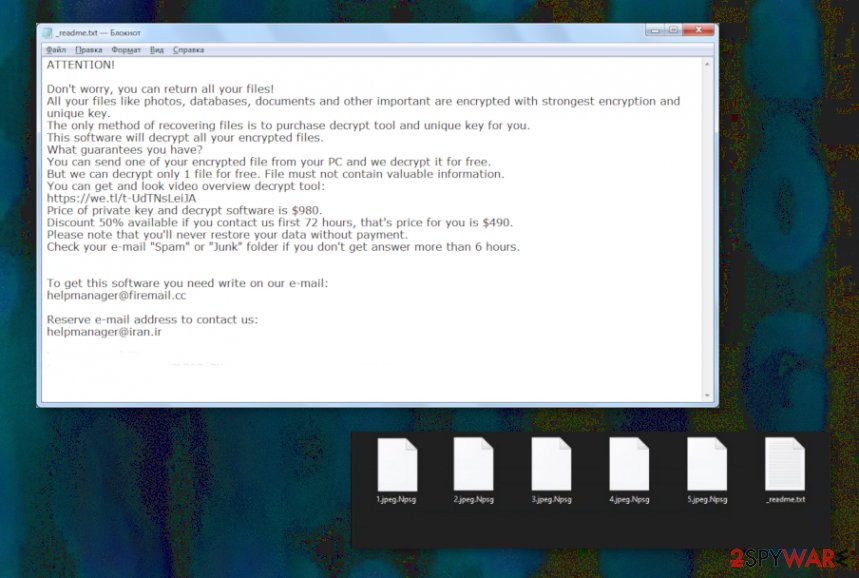Npsg ransomware (Free Guide) - Decryption Steps Included
Npsg virus Removal Guide
What is Npsg ransomware?
Npsg ransomware is the threat that masks its malicious processes by showing false Windows update pop-ups

Even though Npsg ransomware virus developers claim to offer the test decryption it is not advised to trust them. This kind offer may be a scam because criminals store some files smaller than 1GB, so they can send you an unencrypted version. Decryption previously was a great option in this Djvu/STOP ransomware family, but recent changes in the coding and methods no longer allowed to use the STOPDecrypter as a tool for file recovery. Victims that get malware developed after August 2019 have fewer options now. Nevertheless, some of the people can decrypt their data with Emsisoft's decryption tool, but that only goes for the ones with a t1 at the end of the victims' ID. Such an ending indicates that offline keys got used in the process.
| Name | Npsg ransomware |
|---|---|
| File marker | .npsg is a random character extension appearing on the file that got encrypted. This extension goas after the original file name and file type marker, so you can at least know what data got encoded and damaged even when you cannot read the contents |
| Family | Djvu virus |
| Danger | This virus encrypts files and blackmails victims by claiming to have a decryption tool that they need for data recovery. It can be dangerous to even contact developers, but paying is not the option, so it may lead to lost money and permanent data loss when files cannot be recovered in any way |
| Distribution | Pirated products deliver payload droppers or other malware that executes the ransomware. Files added on emails as attachments also can be injected with malicious macros that have the same purpose of spreading cryptovirus |
| Ransom note | _readme.txt is the file that gets placed on the desktop and in other places where the victim can see, so the ransom demanding message reaches the person. This file is the one that has all the contact information and details about making the payment |
| Elimination | The process can be more difficult than you think because Npsg ransomware removal requires attention to details and professional anti-malware tools that can do the best job of terminating this malware |
| System cleaning | Since ransomware infiltrates the system silently it can run in the background and make various changes, that you need to reverse to get to the normal working computer. For that, we would recommend going for proper system tools like FortectIntego that might fix the affected files and virus damage for you |
Npsg ransomware comes from the developers of well-known Djvu and STOP ransomware viruses. This is the 200th version already and comes after a handful of other variants that victimized many people around the globe. There was a time when many people got their files recovered and fully restored infected devices thanks to researchers.
However, that was possible due to offline keys that developers used for a long time. Since summer 2019, the encryption coding got altered and now includes online victim IDs that are generated for each person separately. Versions after that, including this most recent one – Npsg ransomware cannot be decrypted unless the virus used offline ID on your device.
The only possible way to recover files is to get data backups or a third party program that is designed to restore affected files. You need to make sure that Npsg ransomware is terminated and no longer active, so your files are safe. Ransomware can detect new files and encrypt them or encode all the files once more what makes them damaged forever, so be careful.
Also, be careful with those criminals that developed this threat because they only care for your money. This is why the encryption process and showing ransom note is the main goal of Npsg ransomware creators. The deliver the following message for victims:
ATTENTION!
Don’t worry, you can return all your files!
All your files like photos, databases, documents and other important are encrypted with strongest encryption and unique key.
The only method of recovering files is to purchase decrypt tool and unique key for you.
This software will decrypt all your encrypted files.
What guarantees you have?
You can send one of your encrypted file from your PC and we decrypt it for free.
But we can decrypt only 1 file for free. File must not contain valuable information.
You can get and look video overview decrypt tool:
https://we.tl/t-Oc0xgfzC7q
Price of private key and decrypt software is $980.
Discount 50% available if you contact us first 72 hours, that’s price for you is $490.
Please note that you’ll never restore your data without payment.
Check your e-mail “Spam” or “Junk” folder if you don’t get answer more than 6 hours.To get this software you need write on our e-mail:
helpmanager@firemail.ccReserve e-mail address to contact us:
helpmanager@iran.irYour personal ID:

If you decide to write them, malicious actors can convince you that there is a bigger issue and you need to pay more or infect the machine with a more severe threat than Npsg ransomware like info-stealer or a trojan. The whole money involvement is dangerous and the risk of getting the computer damaged permanently is real.
Try to ignore those scary messages and claims about the loss of your data and try to remove Npsg ransomware right away. The sooner you get to clean the machine the better, but you can still consider the decryption in the future and store some affected or malware related files on a different external device, in case researchers could release a new option in the future.
If you don't trust decryption and want to get rid of the threat to be recover affected valuables as soon as possible, get anti-malware tools or use the security tool that you already own and scan the machine. Things about Npsg ransomware removal that experts[2] want you to consider:
- detection names shouldn't be important for you, as long as it is the threat that you need to get rid of;
- different tools use different databases, so you may need to try a few programs until it properly works;
- virus removal cannot restore encrypted files or affect other functions, it only cleans the traces of cryptovirus.

Stay away from sharing services and pirating sites to avoid malware
It may be old news, but the internet is filled with misleading, deceptive and sometimes even dangerous content. Malicious actors create particularly infected websites where a few clicks can lead to malware infiltration. There are many types of files that can be injected with malicious code or have the payload directly embedded in data.
The most common way of distribution in this particular ransomware family is torrent sites, file-sharing services that provide pirated software[3] with additional malware material:
- licensed versions of programs;
- cracks;
- game cheats.
Once the person installs such files they also get the file with ransomware payload or a direct executable file with malware on it. Such payload can be injected on document files attached to email notifications, so people skip through checking and loads the virus directly on the computer.
Terminate all files related to Npsg ransomware before going for any of the data recovery options
When dealing with Npsg ransomware virus it is important to note that encryption is not the only process that the virus runs on the infected device. Even though it affects your important files and makes data useless, you need to know that in time this threat can damage the computer permanently.
This is why you need to remove Npsg ransomware from the machine as soon as possible, until the serious damage. The best option for this would be anti-malware programs like SpyHunter 5Combo Cleaner or Malwarebytes. Antivirus engines that are based on detecting malicious programs can find various parts of the virus and delete them.
It is important for Npsg ransomware removal that you are terminating all parts of the threat and there is no possibility that encryption can be sent to occur again. To check the essential parts of the system and fix virus damage, you should run FortectIntego. After system repair, you can freely restore encrypted data from a backup.
Getting rid of Npsg virus. Follow these steps
Manual removal using Safe Mode
Get rid of Npsg ransomware by rebooting the machine in Safe Mode with Networking and then running the AV tool
Important! →
Manual removal guide might be too complicated for regular computer users. It requires advanced IT knowledge to be performed correctly (if vital system files are removed or damaged, it might result in full Windows compromise), and it also might take hours to complete. Therefore, we highly advise using the automatic method provided above instead.
Step 1. Access Safe Mode with Networking
Manual malware removal should be best performed in the Safe Mode environment.
Windows 7 / Vista / XP
- Click Start > Shutdown > Restart > OK.
- When your computer becomes active, start pressing F8 button (if that does not work, try F2, F12, Del, etc. – it all depends on your motherboard model) multiple times until you see the Advanced Boot Options window.
- Select Safe Mode with Networking from the list.

Windows 10 / Windows 8
- Right-click on Start button and select Settings.

- Scroll down to pick Update & Security.

- On the left side of the window, pick Recovery.
- Now scroll down to find Advanced Startup section.
- Click Restart now.

- Select Troubleshoot.

- Go to Advanced options.

- Select Startup Settings.

- Press Restart.
- Now press 5 or click 5) Enable Safe Mode with Networking.

Step 2. Shut down suspicious processes
Windows Task Manager is a useful tool that shows all the processes running in the background. If malware is running a process, you need to shut it down:
- Press Ctrl + Shift + Esc on your keyboard to open Windows Task Manager.
- Click on More details.

- Scroll down to Background processes section, and look for anything suspicious.
- Right-click and select Open file location.

- Go back to the process, right-click and pick End Task.

- Delete the contents of the malicious folder.
Step 3. Check program Startup
- Press Ctrl + Shift + Esc on your keyboard to open Windows Task Manager.
- Go to Startup tab.
- Right-click on the suspicious program and pick Disable.

Step 4. Delete virus files
Malware-related files can be found in various places within your computer. Here are instructions that could help you find them:
- Type in Disk Cleanup in Windows search and press Enter.

- Select the drive you want to clean (C: is your main drive by default and is likely to be the one that has malicious files in).
- Scroll through the Files to delete list and select the following:
Temporary Internet Files
Downloads
Recycle Bin
Temporary files - Pick Clean up system files.

- You can also look for other malicious files hidden in the following folders (type these entries in Windows Search and press Enter):
%AppData%
%LocalAppData%
%ProgramData%
%WinDir%
After you are finished, reboot the PC in normal mode.
Remove Npsg using System Restore
System Restore feature can recover the machine in the previous state when the virus was not active
-
Step 1: Reboot your computer to Safe Mode with Command Prompt
Windows 7 / Vista / XP- Click Start → Shutdown → Restart → OK.
- When your computer becomes active, start pressing F8 multiple times until you see the Advanced Boot Options window.
-
Select Command Prompt from the list

Windows 10 / Windows 8- Press the Power button at the Windows login screen. Now press and hold Shift, which is on your keyboard, and click Restart..
- Now select Troubleshoot → Advanced options → Startup Settings and finally press Restart.
-
Once your computer becomes active, select Enable Safe Mode with Command Prompt in Startup Settings window.

-
Step 2: Restore your system files and settings
-
Once the Command Prompt window shows up, enter cd restore and click Enter.

-
Now type rstrui.exe and press Enter again..

-
When a new window shows up, click Next and select your restore point that is prior the infiltration of Npsg. After doing that, click Next.


-
Now click Yes to start system restore.

-
Once the Command Prompt window shows up, enter cd restore and click Enter.
Bonus: Recover your data
Guide which is presented above is supposed to help you remove Npsg from your computer. To recover your encrypted files, we recommend using a detailed guide prepared by 2-spyware.com security experts.If your files are encrypted by Npsg, you can use several methods to restore them:
Data Recovery Pro can be the software you need
When the person is not backing files occasionally, files affected by Npsg ransomware virus can get recovered with the help of Data Recovery Pro
- Download Data Recovery Pro;
- Follow the steps of Data Recovery Setup and install the program on your computer;
- Launch it and scan your computer for files encrypted by Npsg ransomware;
- Restore them.
Windows Previous versions can restore files idividually
System Restore feature enables the method of data recovery with Windows Previous Versions
- Find an encrypted file you need to restore and right-click on it;
- Select “Properties” and go to “Previous versions” tab;
- Here, check each of available copies of the file in “Folder versions”. You should select the version you want to recover and click “Restore”.
ShadowExplorer – an alternate program for Npsg ransomware encrypted data recovery
When Shadow Volume Copies are untouched, ShadowExplorer can help and restore affected data for you
- Download Shadow Explorer (http://shadowexplorer.com/);
- Follow a Shadow Explorer Setup Wizard and install this application on your computer;
- Launch the program and go through the drop down menu on the top left corner to select the disk of your encrypted data. Check what folders are there;
- Right-click on the folder you want to restore and select “Export”. You can also select where you want it to be stored.
You can possibly decrypt files affected by some of the versions
When ransomware uses offline keys, you can use Djvu ransomware decrypter
Finally, you should always think about the protection of crypto-ransomwares. In order to protect your computer from Npsg and other ransomwares, use a reputable anti-spyware, such as FortectIntego, SpyHunter 5Combo Cleaner or Malwarebytes
How to prevent from getting ransomware
Protect your privacy – employ a VPN
There are several ways how to make your online time more private – you can access an incognito tab. However, there is no secret that even in this mode, you are tracked for advertising purposes. There is a way to add an extra layer of protection and create a completely anonymous web browsing practice with the help of Private Internet Access VPN. This software reroutes traffic through different servers, thus leaving your IP address and geolocation in disguise. Besides, it is based on a strict no-log policy, meaning that no data will be recorded, leaked, and available for both first and third parties. The combination of a secure web browser and Private Internet Access VPN will let you browse the Internet without a feeling of being spied or targeted by criminals.
No backups? No problem. Use a data recovery tool
If you wonder how data loss can occur, you should not look any further for answers – human errors, malware attacks, hardware failures, power cuts, natural disasters, or even simple negligence. In some cases, lost files are extremely important, and many straight out panic when such an unfortunate course of events happen. Due to this, you should always ensure that you prepare proper data backups on a regular basis.
If you were caught by surprise and did not have any backups to restore your files from, not everything is lost. Data Recovery Pro is one of the leading file recovery solutions you can find on the market – it is likely to restore even lost emails or data located on an external device.
- ^ Encryption. Wikipedia. The free encyclopedia.
- ^ Avirus. Avirus. Spyware related news.
- ^ Hidden risks in pirated software. Microsoft. Asia News Center.







